More countries are currently set to be in a worse position with regards to the UN SDG 6 goal in 2030 than at the time of adoption in 2015.

Beyond these numbers, there’s a lot the Water Industry can and shall do to better the lives of a wide portion of humanity when it comes to water and sanitation.
The good news is that, as we will see, the cost of doing good, taking action, progressing towards a sustainable future, and protecting everyone’s health is smaller than the cost of inaction.
… And achieving the United Nations’ Sustainable Development Goals represents a tremendous business opportunity!
Table of contents
- 1. The UN SDG 6 ambition: bring Water and Sanitation for All by 2030
- 2. It is part of the United Nation’s 2030 Agenda for Sustainable Development
- 3. The Sustainable Development Goals follow the steps of the Millennium Development Goals
- 4. Progress towards achievement of SDG 6 is running (very) late
- 5. The UN 2030 Agenda draws on the concept of Sustainable Development – and there might be a problem with it
- 6. Sustainable Development Goals are a tremendous Business Development Opportunity
- Graphical Summary of the progress towards UN SDG 6 as of 2022:
- Did the UN Water Conference bring SDG 6 back on track?
- The Water Action Agenda – the SDG 6 White Knight?
- Question: is World Water Day doing any good?
- Question: What’s the Influencer’s role in Achieving SDG 6?
1. The UN SDG 6 ambition: bring Water and Sanitation for All by 2030
The recent CoVid 19 pandemic reminded us of how important hygiene services are to our overall health. Yet, the first component of hygiene – safe access to clean water – is by far not a given for a large portion of humanity.
The World experienced a fast growth throughout the past century: this was true for the population, that went from 2 billion people in 1900 to 7 billion as I write this, and soon 10 billion. But this was also true for our water uses! These grew twice faster than population, because of the increased needs of Industries and Agriculture.
As a result, Water Scarcity, Water Stress, and increased pollution levels started to threaten our World. As anachronic as it sounds, one million people die from water, sanitation, and hygiene (WASH) related diseases every year, and a child dies every 2 minutes from a water-related disease!
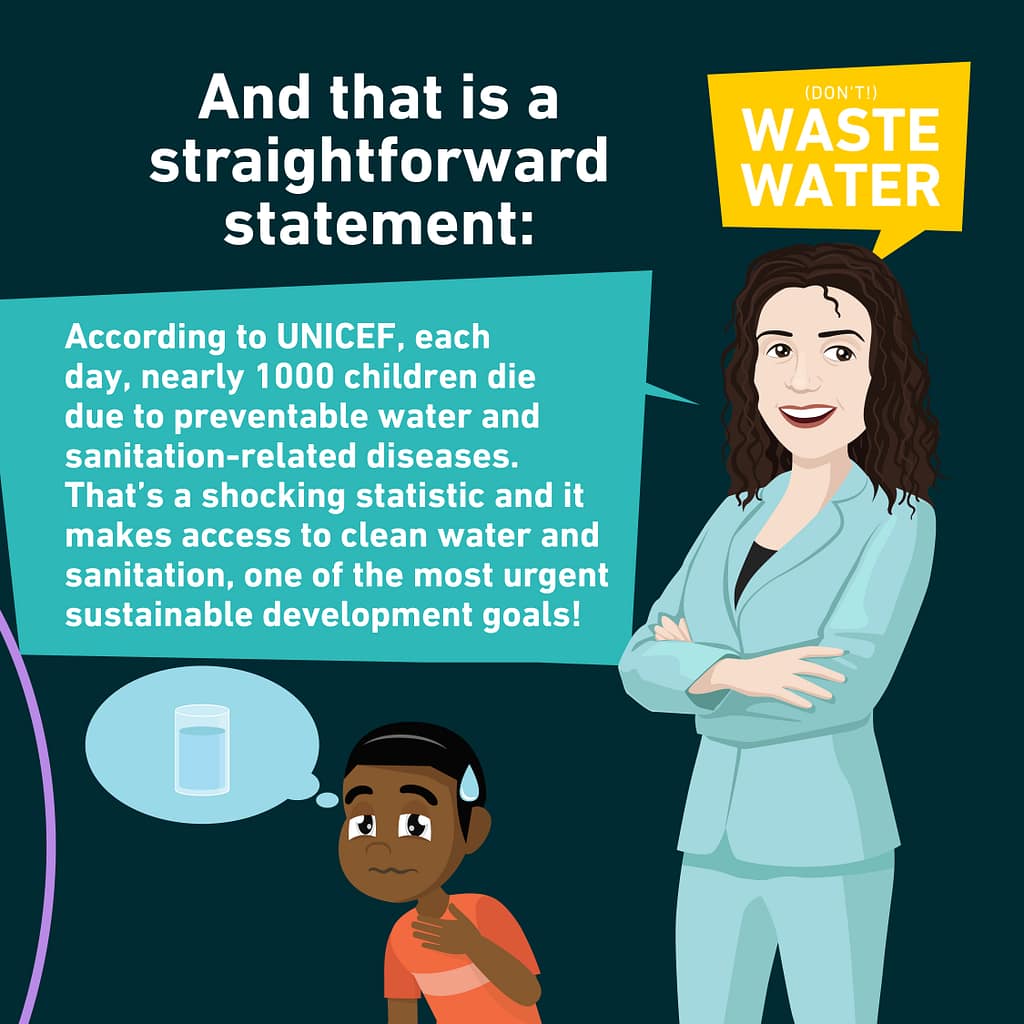
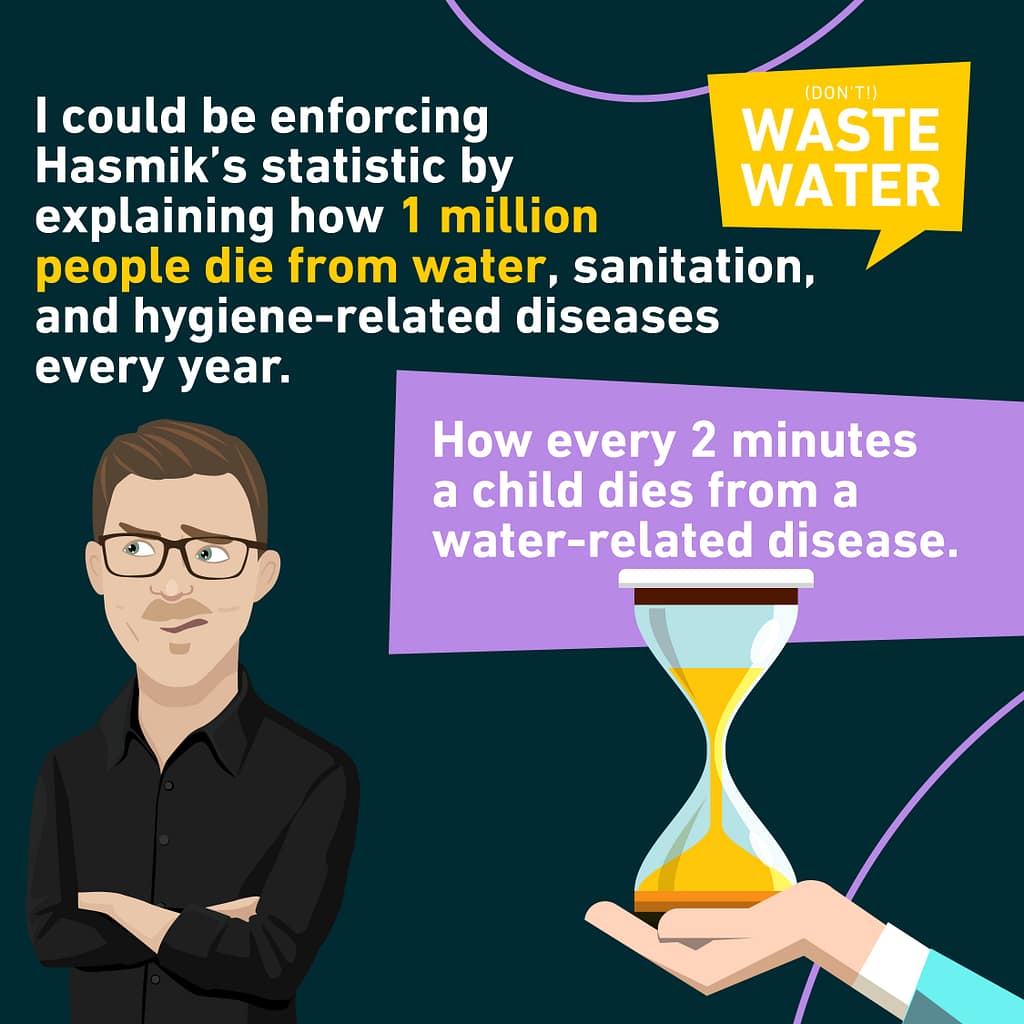
To solve this challenge, the United Nations set the goal to provide clean water and Sanitation services for all by 2030.
6+2 Subgoals for the UN SDG 6
The global UN SDG 6 Goal is broken down by subgoals as follows:
- 6.1 intends to achieve universal access to safe and affordable drinking water for all. It is often referred to “Human Right to Water” as a proxy to that subgoal.
- 6.2 is 6.1‘s counterpart when it comes to adequate and equitable sanitation and hygiene for all. A specific focus is given here to the protection of girls and women in vulnerable situations.
- 6.3 targets and improved water quality by reducing pollution and avoiding as much as possible to release dangerous chemicals into the environment. Generally speaking, the world shall divide by two its discharge of untreated wastewater to nature.
- 6.4 aims at increasing water efficiency or said differently to make every drop count
- 6.5 pushes for better planning and management of water resources at all levels, including across borders
- 6.6 dedicated to natural resources and ecosystems that shall be better protected and hopefully restored
Then, two additional subgoals complete this set of targets:
- 6.a is an overall call for international cooperation and action. It targets specific areas of the Water Industry, such as desalination, water harvesting, wastewater treatment, water efficiency, and recycling & reuse technologies
- 6.b pushes toward the “How” of the rollout of the UN SDG 6, with a specific focus on community involvement
To learn more about the United Nation’s Sustainable Development Goal number six, have a look at my detailed deep dive on the topic!
2. It is part of the United Nation’s 2030 Agenda for Sustainable Development
If we zoom out from the UN SDG 6 for a minute, we realize that it is part of the United Nation’s Agenda 2030. Adopted by 193 countries at the United Nations in September 2015, it contains 17 goals (the famous “SDGs”) divided into 169 targets.
Beyond continuing the work that the Millennium Development Goals started (more about MDGs in a minute!), they put a specific emphasis on gender equality and the empowerment of all women and girls.
Generally speaking, they are built upon sustainability’s triple bottom: the economic, social, and environmental dimensions.
Some of Agenda 2030’s strong commitments are:
- The pledge to end poverty and hunger everywhere
- The engagement to build peaceful and inclusive societies
- The ambition to protect the planet and its natural resources
- The willingness to build sustained growth leading to shared global prosperity
- The promise that no one would be left behind



Check my deep dive on the United Nation’s 2030 Agenda to learn more about the matter.
3. The Sustainable Development Goals follow the steps of the Millennium Development Goals
Providing clean water for all isn’t exactly a new ambition. In recent history, it can be traced back to the 1977 Mar del Plata conference of the United Nations, which first declared that all people had the right to access drinking water services in quantities and quality equal to their basic needs.
It would be followed from 1981 to 1990 by the “International Drinking Water Supply and Sanitation Decade.” In 1993, the United Nations created the “World Water Day” which is celebrated every year since on 22 March.
(it was since completed with the “World Toilet Day” in 2013, which happens on 19 November)
Everything further escalated and intensified with the Millennium Development Goals (MDGs) in 2000. In a similar fashion to the Agenda 2030 that was set in 2015 (as we just reviewed), these MDGs listed 8 targets and gave the World 15 years to achieve them, so until 2015.
The Millennium Development Goals for Water
By 2015, the World shall halve the proportion of people without access to safe drinking water and basic sanitation.
This was supposed to cost about $2-23 billion to divide the proportion of people without a safe water supply by two. Meanwhile, data shows that for basic sanitation, the global investment was evaluated at $2-17 billion.
The concept of “safe” itself was subject to interpretation, as it wasn’t explicitly detailed within the MDG Goal 7c afferent to clean water, while the UN SDG 6.1 defines it as “Water that is free from contamination and readily available at the household level.”
For wastewater, it was even slightly worse. Even the “Improved” level was subject to debate when comparing MDG 7c with UN SDG 6.2.
If you’d like to go into all the details, tricks, and history of the Millennium Development Goals, have a look at my specific focus article.
Yet, what’s to remember from the MDGs is that they reached the targetted amount of people whose situation shall be bettered with regards to Water, Sanitation, and Hygiene (about 2 billion people). But in the meantime (2000-2015), the world’s population also grew by about 2 billion, so that at the end of the day, the number of people without satisfactory access to Water and Sanitation did not change…
4. Progress towards achievement of SDG 6 is running (very) late
I think the title explains it well, but here’s how it looks in cartoons:
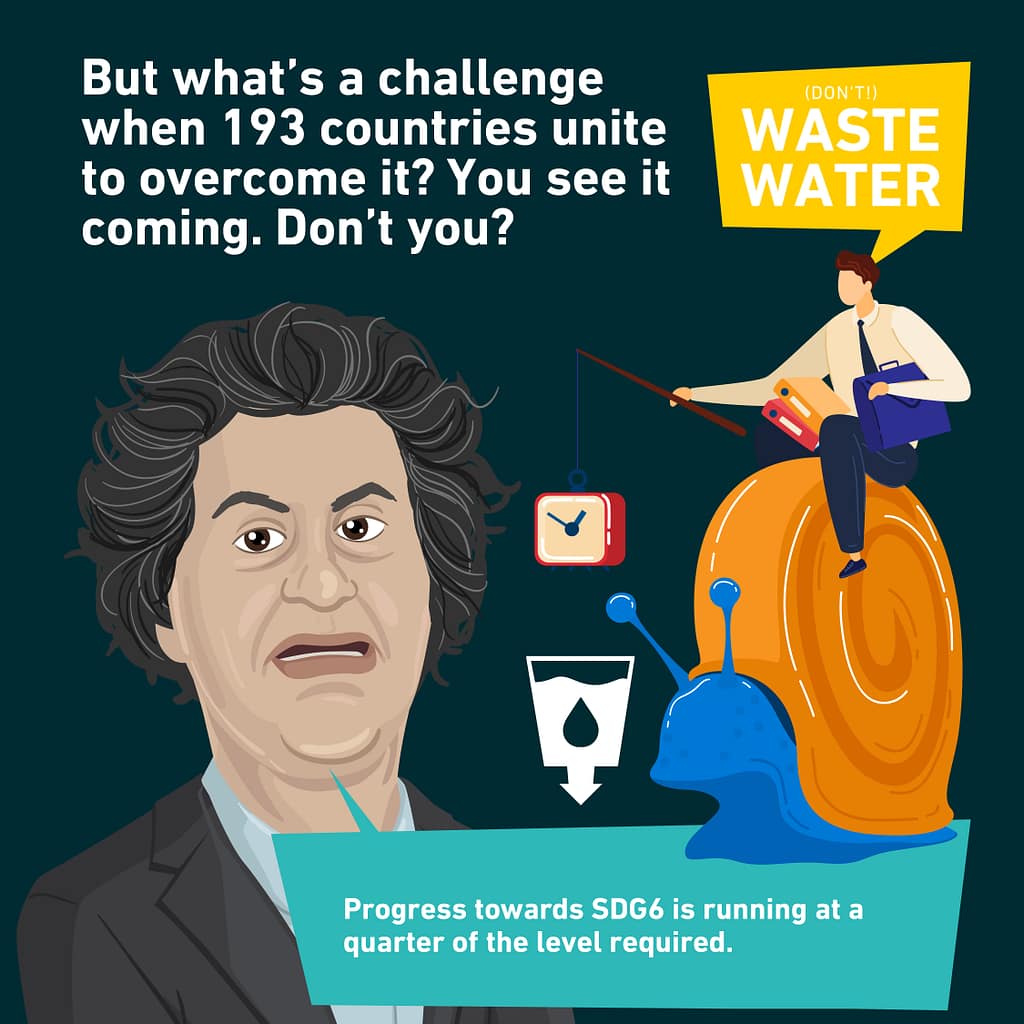
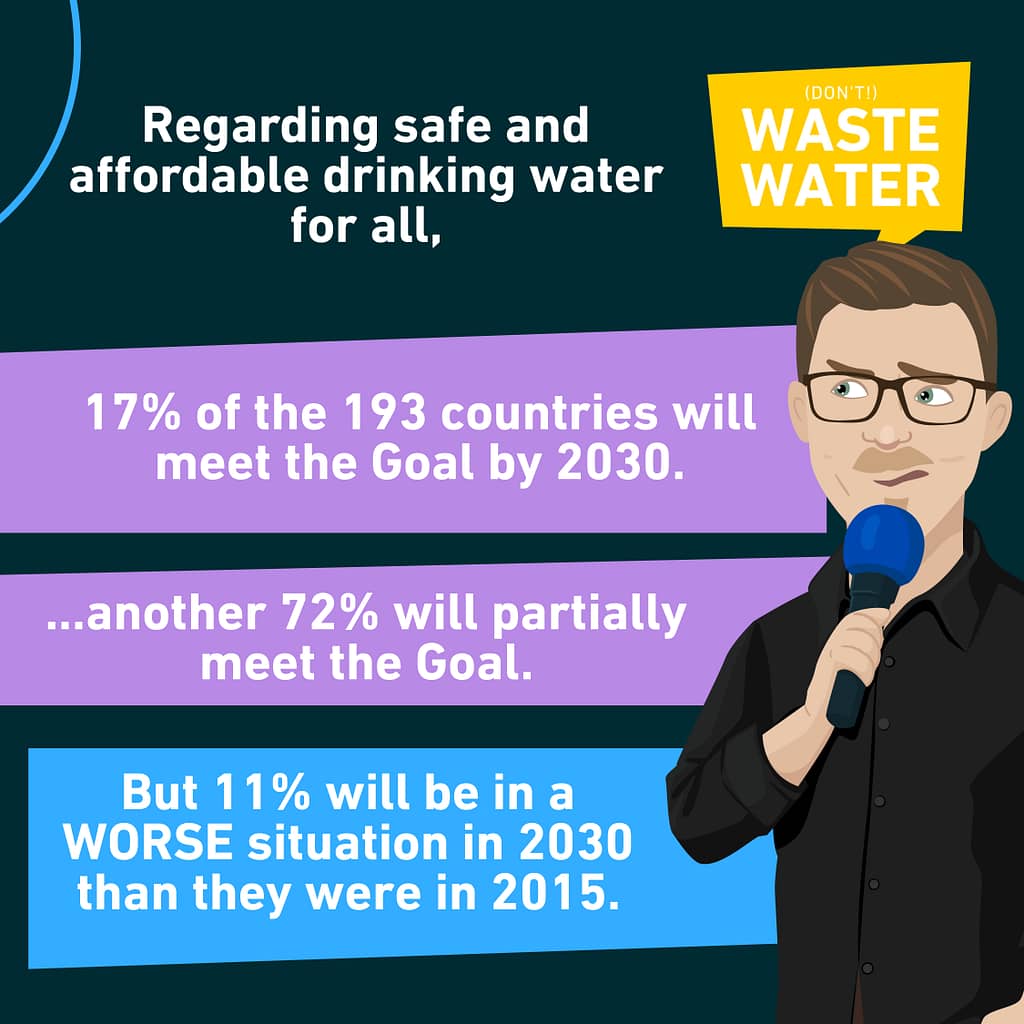
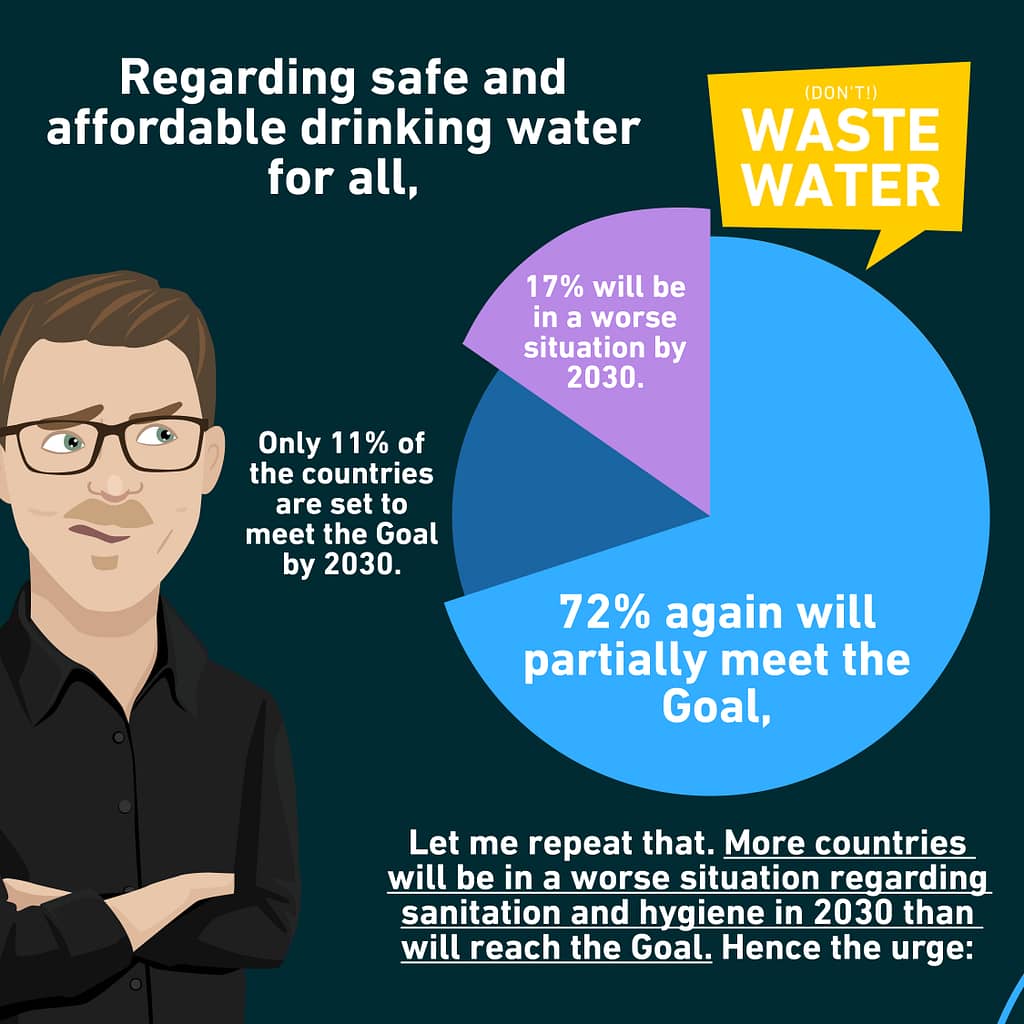
So the achievement of the UN SDG 6 is not only running late but also set to go… backward, especially for Wastewater and Hygiene.
You can check it out for yourself on the official UN tracker right here!
Indeed, when it comes to Water, if we won’t hit the goal, more countries still will meet it than miss it. But for wastewater, 17% of the countries will be worse off in 2030 than in 2015!
Why so? Well, it’s a matter of finance:
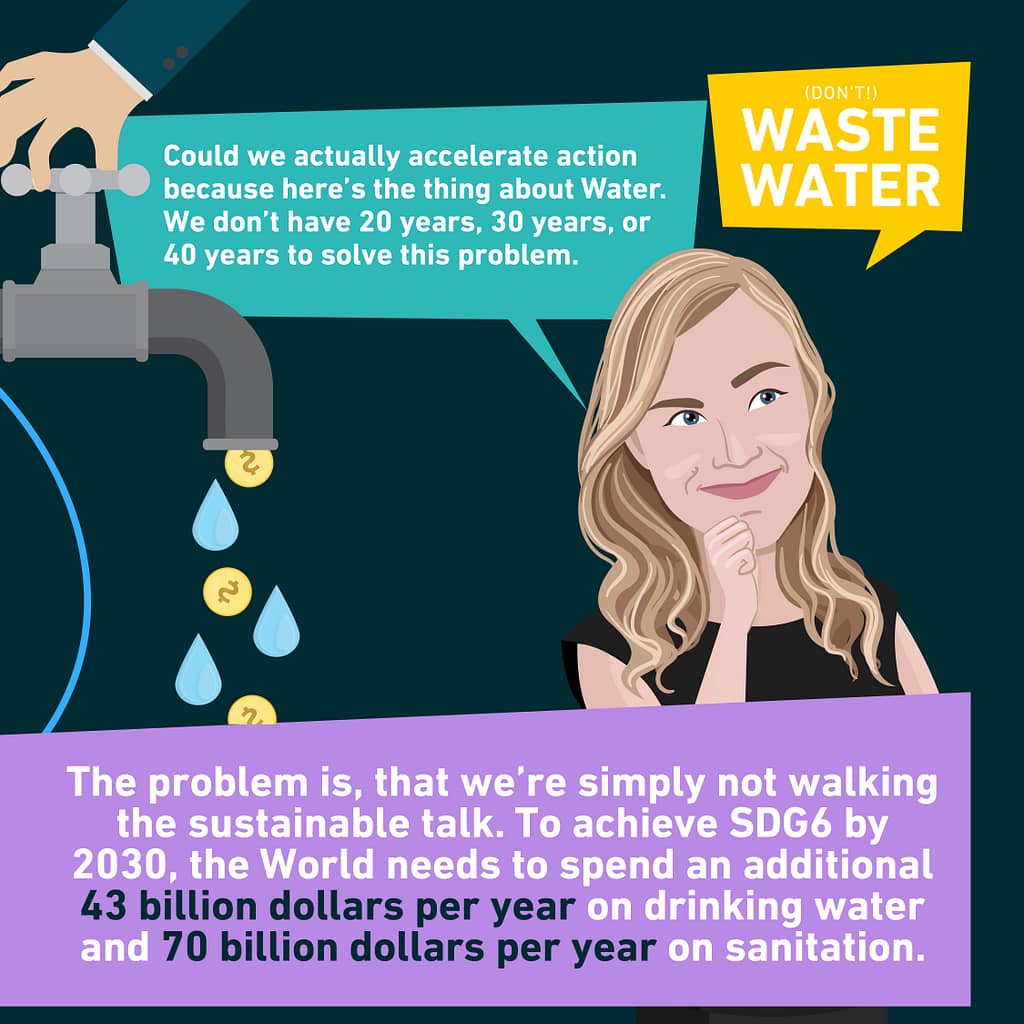
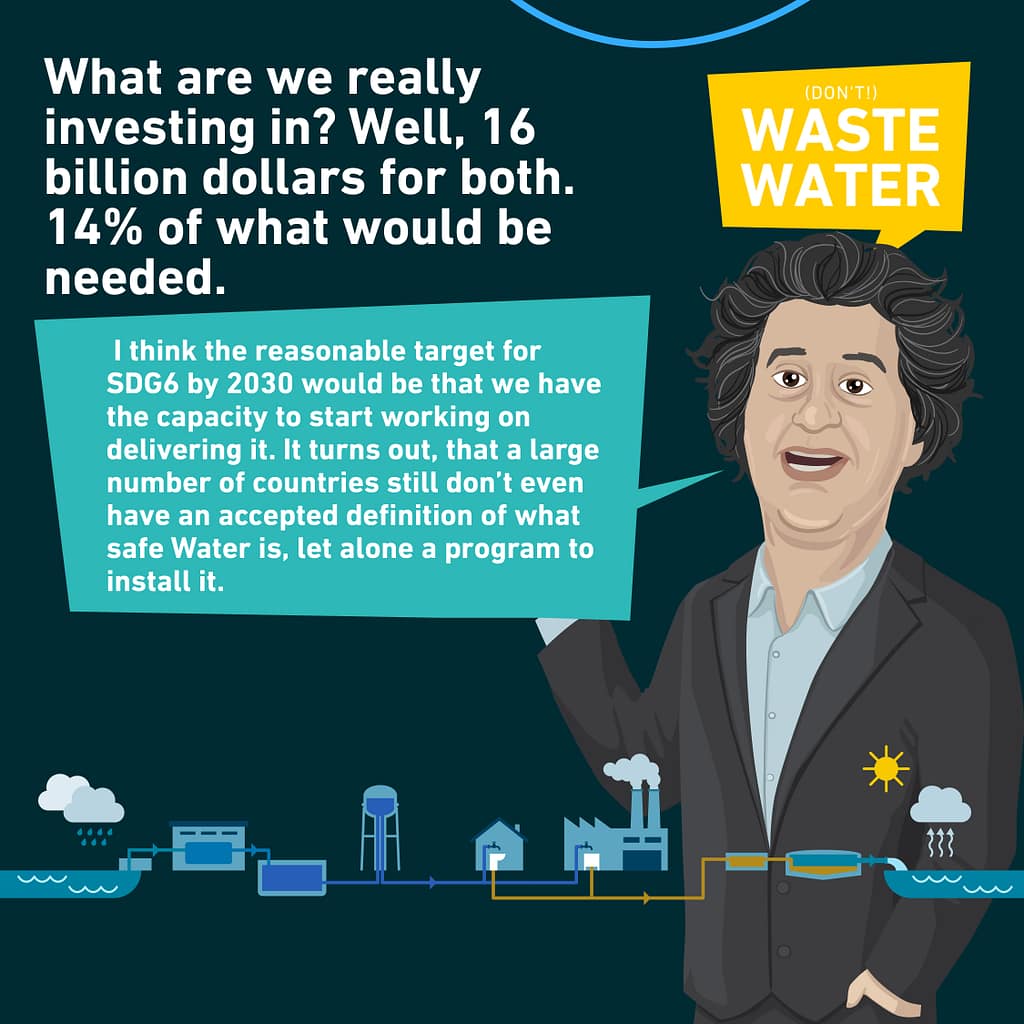
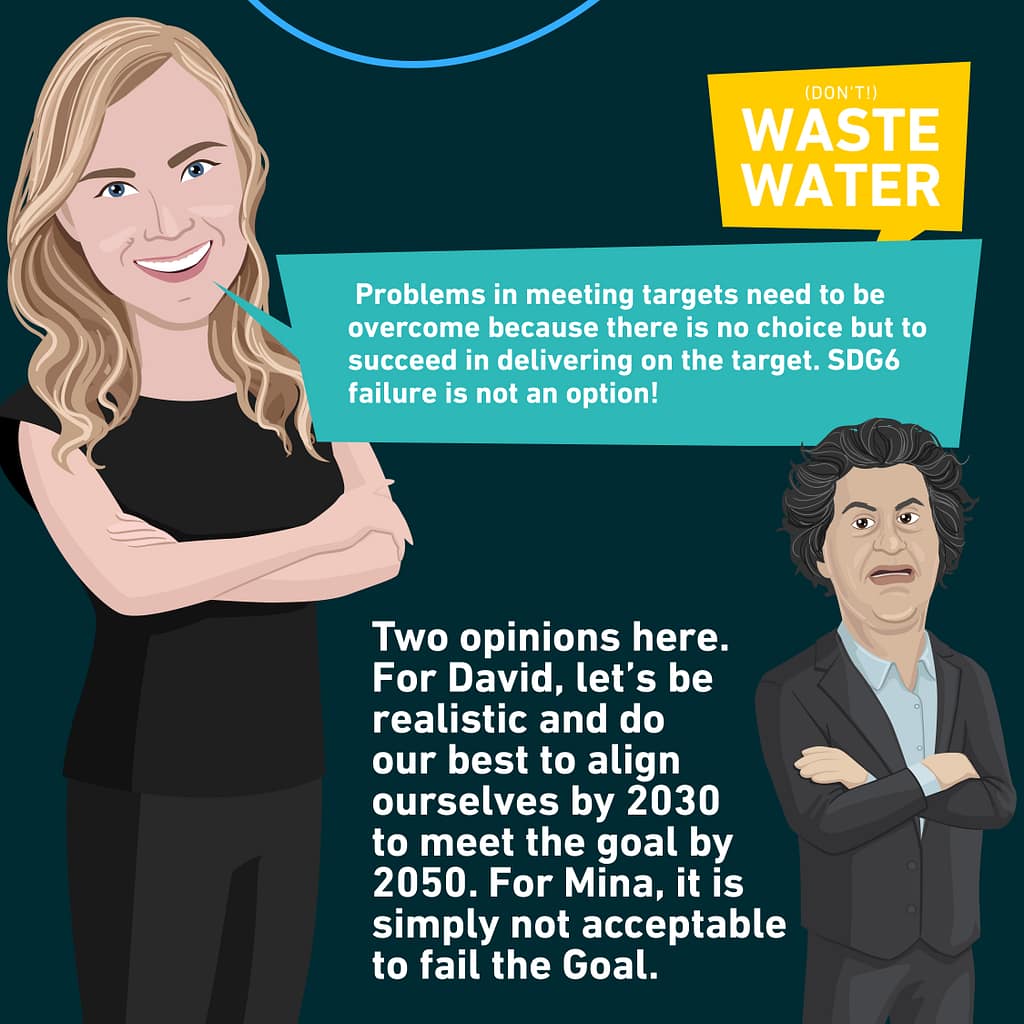
The world is currently spending $16 billion per year on achieving the UN SDG 6. To reach the target, we should invest $43 billion in Water and $70 billion in sanitation, about 7 times more!
Now if states keep failing at reaching the goal, could the private and NGO scene fill-in? There may well be a problem with water charities, yet there are also promising solutions rising there (e.g., microcredit)
5. The UN 2030 Agenda draws on the concept of Sustainable Development – and there might be a problem with it
More specifically, as we’ve seen on Agenda 2030, the UN SDG follows the Triple Bottom Line concept. John Elkington coined the term in 1994 to describe how social, environmental, and financial aspects support sustainable development.
(The concept of sustainability itself is around for a while: it was already used centuries ago in forest management. Wanna learn more? Check my deep dive on the matter!)
The problem is, that the concept is maybe becoming too popular. As a result, companies become experts in explaining how they comply with it without changing anything in their market approach:
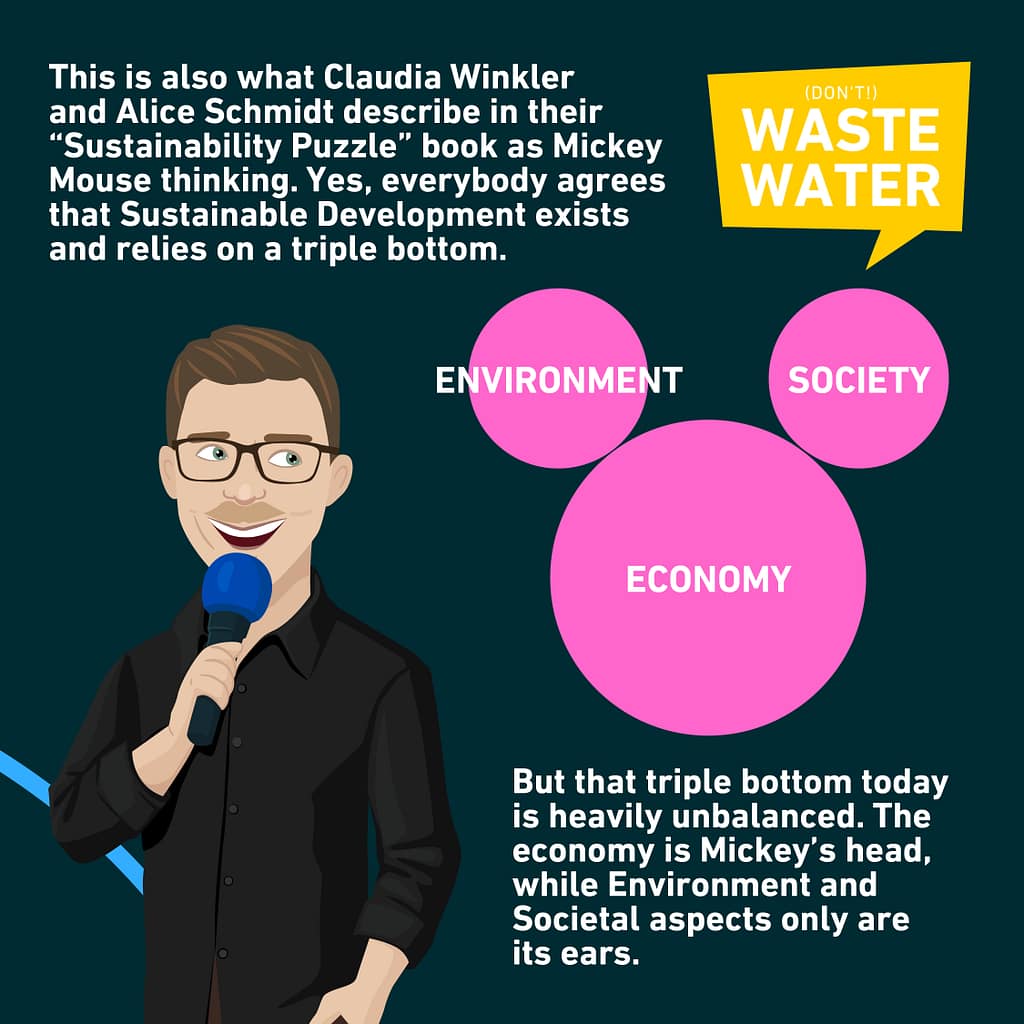
John Elkington even decided to recall his concept in a Harvard Business Review article! A more recent and popular approach takes the problem from the other angle. It states that if you identify an environmental or societal problem and aim to solve it, “economy” will come as a by-product. So will we soon see a “reverse Mickey Mouse Head?”
Maybe, who knows? 😀
6. Sustainable Development Goals are a tremendous Business Development Opportunity
What about adding 10% to the World’s Economy? Would you be interested in an additional 12 trillion dollars and 380 million jobs?
This is the magnitude of impact we’re talking about when it comes to the UN Sustainable Development Goals. The data I’m quoting here come from an official United Nations research study called “Valuing the SDG Prize.” And they only review 60 of the 169 targets I mentioned earlier!
90% of this value creation would be located in developing countries. And it does not include yet the welcome side-effects, such as reducing armed conflicts, obesity, or climate change.
In a nutshell, it’s an opportunity for a Win-Win: doing good on a broad scale, while creating sustainable growth. I guess we’re far here from the usual image of ecology or sustainability being a sport for charities!
So what are we waiting to ensure clean water and safe wastewater services to all?
Graphical Summary of the progress towards UN SDG 6 as of 2022:
1262143-Instagram-SDG6_Op2_010622Would you like to know more about the world’s current progress towards UN SDG 6? I’ve asked 16 experts for insights!
Did the UN Water Conference bring SDG 6 back on track?
This March 2023 in New York, the UN Water Conference was tasked with an impossible challenge: bringing SDG 6 back on track, after a 46 years hiatus since its last edition.
If the UN Water Conference indeed brought together leaders from around the world to discuss the urgent need for improved access to clean water and sanitation, it was a bit lighter on action commitments.
The conference highlighted the devastating impact of water scarcity on communities, particularly in developing countries, and called for greater investment in water infrastructure and technology. Participants also emphasized the importance of equitable water distribution and the need to involve local communities in water management solutions.
The somewhat unfortunate conclusion is, that the UN and its partners will continue to work towards achieving the Sustainable Development Goal of ensuring clean water and sanitation for all by 2030, aka SDG 6.
Still, as I personally had high hopes for this conference, I covered it Day by Day, which you can see in these videos:
The Water Action Agenda – the SDG 6 White Knight?
The Water Action Agenda is a critical outcome of the UN Water Conference we just discussed. It is designed to be the main instrument for achieving the conference’s objectives, which include improving access to clean water and sanitation, managing water resources sustainably, and promoting international cooperation on water-related issues.
(Why do I keep repeating that? I mean, if you’re here, you know that’s SDG 6!)
The Water Action Agenda is a comprehensive framework that outlines the key actions and strategies needed to achieve these objectives. It provides a roadmap for policymakers, stakeholders, and the general public to work together toward ensuring everyone has access to safe and sufficient water resources. Overall, the Water Action Agenda shall become a vital tool for advancing global water management and achieving sustainable development goals.
Well, that’s what we were told, but when you dive deeper:
Question: is World Water Day doing any good?
As we’ve seen, the road to achieving the UN SDG 6 is not so straightforward. Yet, the United Nations suspected, this would be a risk. Why? Well, out of experience.
Indeed, SDG6 is not the World’s first attempt at bringing water and sanitation for all. Before that, we’ve had the Water Decade or the Millennium Development Goals.
To raise awareness on these ongoing initiatives, the international community had thought of its usual patch: organizing once a year, a big event, to remind everyone of the challenge.
This is how World Water Day was born, in December 1992!
Did it succeed? To other extents, arguably yes. But for its core purpose, clearly no.
So isn’t it about time to rethink what World Water Day is and shall be? I’ve been reviewing.
Question: What’s the Influencer’s role in Achieving SDG 6?
I’ve regularly talked about Matt Damon’s impressive work with Gary White at Water.org. They’re to be credited with bringing water to 50 million people in a decade, arguably more than any single government or international institution over the same timeframe. Recently, the “influencer club” was enlarged by MrBeast’s effort to drill 100 water wells in Africa, bringing water to 500’000 people at once.
MrBeast’s ambitious project to drill wells across Africa resonates with the heart of the UN Sustainable Development Goal 6, boldly tackling the global water crisis head-on. His campaign promises more than a transient headline, aiming to deliver a tangible change in the daily lives of thousands by securing access to clean, safe drinking water. However, the endeavor isn’t without its complexities. The initiative prompts us to ask critical questions: What about the longevity of these wells? How will local communities be equipped to manage and maintain them, ensuring they’re not just a temporary fix but a sustainable source of life?
MrBeast drills 100 Wells – but there’s more to the story
In the analytical realm, MrBeast’s project is a springboard for deeper examination. It’s an invitation to scrutinize the efficacy of such interventions, challenging us to peer beyond the act of giving and into the realm of empowerment and education. This work beckons us to consider the full spectrum of water safety and sustainability – from the source’s purity to the socioeconomic ripple effects of the aid. It’s not just about reaching a goal; it’s about weaving a stronger social fabric that holds the weight of water security, economic stability, and environmental preservation.
If that’s a topic you’d like to explore further, here’s my water pro reacts to MrBeast deep dive.

